Ines Rieger
An Embedding is Worth a Thousand Noisy Labels
Aug 26, 2024Abstract:The performance of deep neural networks scales with dataset size and label quality, rendering the efficient mitigation of low-quality data annotations crucial for building robust and cost-effective systems. Existing strategies to address label noise exhibit severe limitations due to computational complexity and application dependency. In this work, we propose WANN, a Weighted Adaptive Nearest Neighbor approach that builds on self-supervised feature representations obtained from foundation models. To guide the weighted voting scheme, we introduce a reliability score, which measures the likelihood of a data label being correct. WANN outperforms reference methods, including a linear layer trained with robust loss functions, on diverse datasets of varying size and under various noise types and severities. WANN also exhibits superior generalization on imbalanced data compared to both Adaptive-NNs (ANN) and fixed k-NNs. Furthermore, the proposed weighting scheme enhances supervised dimensionality reduction under noisy labels. This yields a significant boost in classification performance with 10x and 100x smaller image embeddings, minimizing latency and storage requirements. Our approach, emphasizing efficiency and explainability, emerges as a simple, robust solution to overcome the inherent limitations of deep neural network training. The code is available at https://github.com/francescodisalvo05/wann-noisy-labels .
CorrLoss: Integrating Co-Occurrence Domain Knowledge for Affect Recognition
Oct 31, 2022Abstract:Neural networks are widely adopted, yet the integration of domain knowledge is still underutilized. We propose to integrate domain knowledge about co-occurring facial movements as a constraint in the loss function to enhance the training of neural networks for affect recognition. As the co-ccurrence patterns tend to be similar across datasets, applying our method can lead to a higher generalizability of models and a lower risk of overfitting. We demonstrate this by showing performance increases in cross-dataset testing for various datasets. We also show the applicability of our method for calibrating neural networks to different facial expressions.
Uncovering the Bias in Facial Expressions
Nov 23, 2020



Abstract:Over the past decades the machine and deep learning community has celebrated great achievements in challenging tasks such as image classification. The deep architecture of artificial neural networks together with the plenitude of available data makes it possible to describe highly complex relations. Yet, it is still impossible to fully capture what the deep learning model has learned and to verify that it operates fairly and without creating bias, especially in critical tasks, for instance those arising in the medical field. One example for such a task is the detection of distinct facial expressions, called Action Units, in facial images. Considering this specific task, our research aims to provide transparency regarding bias, specifically in relation to gender and skin color. We train a neural network for Action Unit classification and analyze its performance quantitatively based on its accuracy and qualitatively based on heatmaps. A structured review of our results indicates that we are able to detect bias. Even though we cannot conclude from our results that lower classification performance emerged solely from gender and skin color bias, these biases must be addressed, which is why we end by giving suggestions on how the detected bias can be avoided.
Multi-label Learning with Missing Values using Combined Facial Action Unit Datasets
Aug 17, 2020

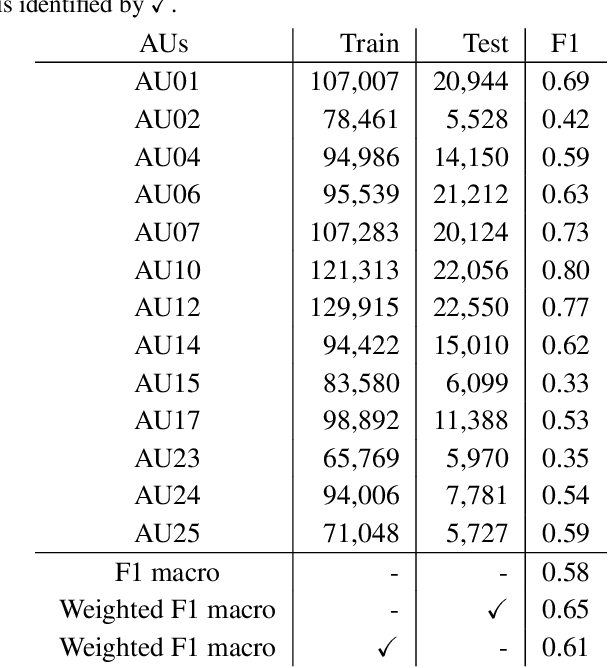
Abstract:Facial action units allow an objective, standardized description of facial micro movements which can be used to describe emotions in human faces. Annotating data for action units is an expensive and time-consuming task, which leads to a scarce data situation. By combining multiple datasets from different studies, the amount of training data for a machine learning algorithm can be increased in order to create robust models for automated, multi-label action unit detection. However, every study annotates different action units, leading to a tremendous amount of missing labels in a combined database. In this work, we examine this challenge and present our approach to create a combined database and an algorithm capable of learning under the presence of missing labels without inferring their values. Our approach shows competitive performance compared to recent competitions in action unit detection.
Unique Class Group Based Multi-Label Balancing Optimizer for Action Unit Detection
Mar 05, 2020
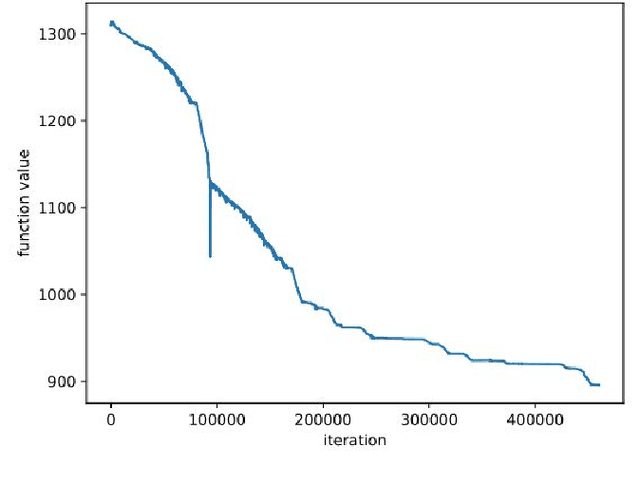
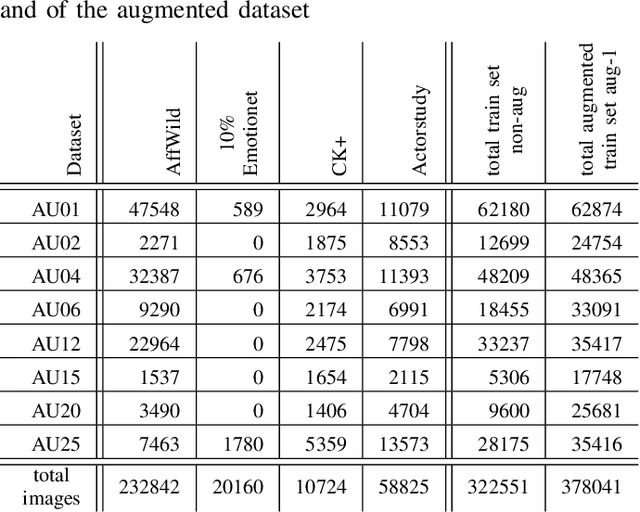
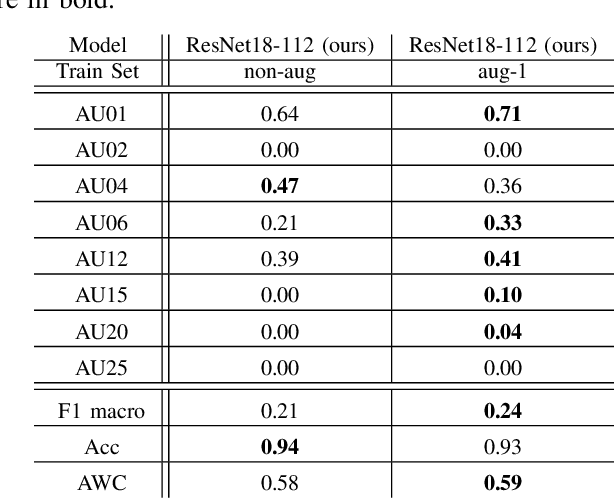
Abstract:Balancing methods for single-label data cannot be applied to multi-label problems as they would also resample the samples with high occurrences. We propose to reformulate this problem as an optimization problem in order to balance multi-label data. We apply this balancing algorithm to training datasets for detecting isolated facial movements, so-called Action Units. Several Action Units can describe combined emotions or physical states such as pain. As datasets in this area are limited and mostly imbalanced, we show how optimized balancing and then augmentation can improve Action Unit detection. At the IEEE Conference on Face and Gesture Recognition 2020, we ranked third in the Affective Behavior Analysis in-the-wild (ABAW) challenge for the Action Unit detection task.
Verifying Deep Learning-based Decisions for Facial Expression Recognition
Feb 14, 2020



Abstract:Neural networks with high performance can still be biased towards non-relevant features. However, reliability and robustness is especially important for high-risk fields such as clinical pain treatment. We therefore propose a verification pipeline, which consists of three steps. First, we classify facial expressions with a neural network. Next, we apply layer-wise relevance propagation to create pixel-based explanations. Finally, we quantify these visual explanations based on a bounding-box method with respect to facial regions. Although our results show that the neural network achieves state-of-the-art results, the evaluation of the visual explanations reveals that relevant facial regions may not be considered.
Multi-Label Class Balancing Algorithm for Action Unit Detection
Feb 08, 2020
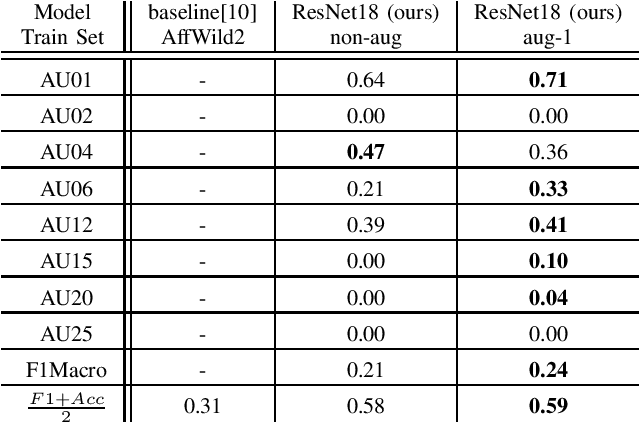
Abstract:Isolated facial movements, so-called Action Units, can describe combined emotions or physical states such as pain. As datasets are limited and mostly imbalanced, we present an approach incorporating a multi-label class balancing algorithm. This submission is subject to the Action Unit detection task of the Affective Behavior Analysis in-the-wild (ABAW) challenge at the IEEE Conference on Face and Gesture Recognition 2020.
Towards Real-Time Head Pose Estimation: Exploring Parameter-Reduced Residual Networks on In-the-wild Datasets
Jun 12, 2019



Abstract:Head poses are a key component of human bodily communication and thus a decisive element of human-computer interaction. Real-time head pose estimation is crucial in the context of human-robot interaction or driver assistance systems. The most promising approaches for head pose estimation are based on Convolutional Neural Networks (CNNs). However, CNN models are often too complex to achieve real-time performance. To face this challenge, we explore a popular subgroup of CNNs, the Residual Networks (ResNets) and modify them in order to reduce their number of parameters. The ResNets are modifed for different image sizes including low-resolution images and combined with a varying number of layers. They are trained on in-the-wild datasets to ensure real-world applicability. As a result, we demonstrate that the performance of the ResNets can be maintained while reducing the number of parameters. The modified ResNets achieve state-of-the-art accuracy and provide fast inference for real-time applicability.
 Add to Chrome
Add to Chrome Add to Firefox
Add to Firefox Add to Edge
Add to Edge